File Info
| Exam | Identity with Windows Server 2016 |
| Number | 70-742 |
| File Name | Microsoft.70-742.PracticeTest.2018-09-27.104q.vcex |
| Size | 3 MB |
| Posted | Sep 27, 2018 |
| Download | Microsoft.70-742.PracticeTest.2018-09-27.104q.vcex |
How to open VCEX & EXAM Files?
Files with VCEX & EXAM extensions can be opened by ProfExam Simulator.
Coupon: MASTEREXAM
With discount: 20%
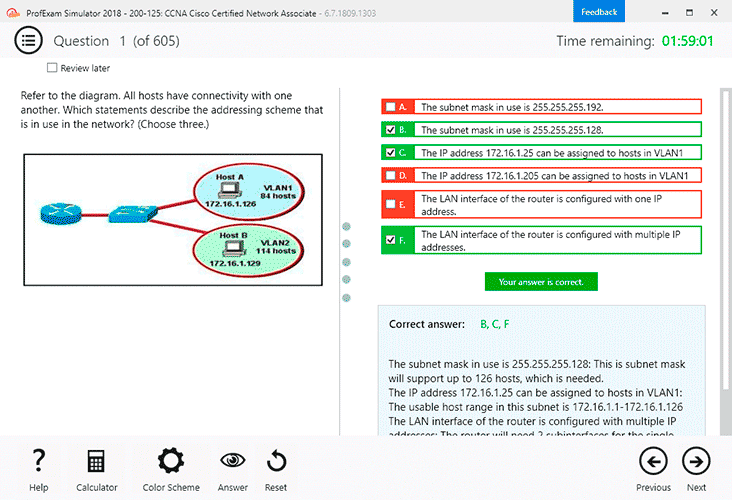
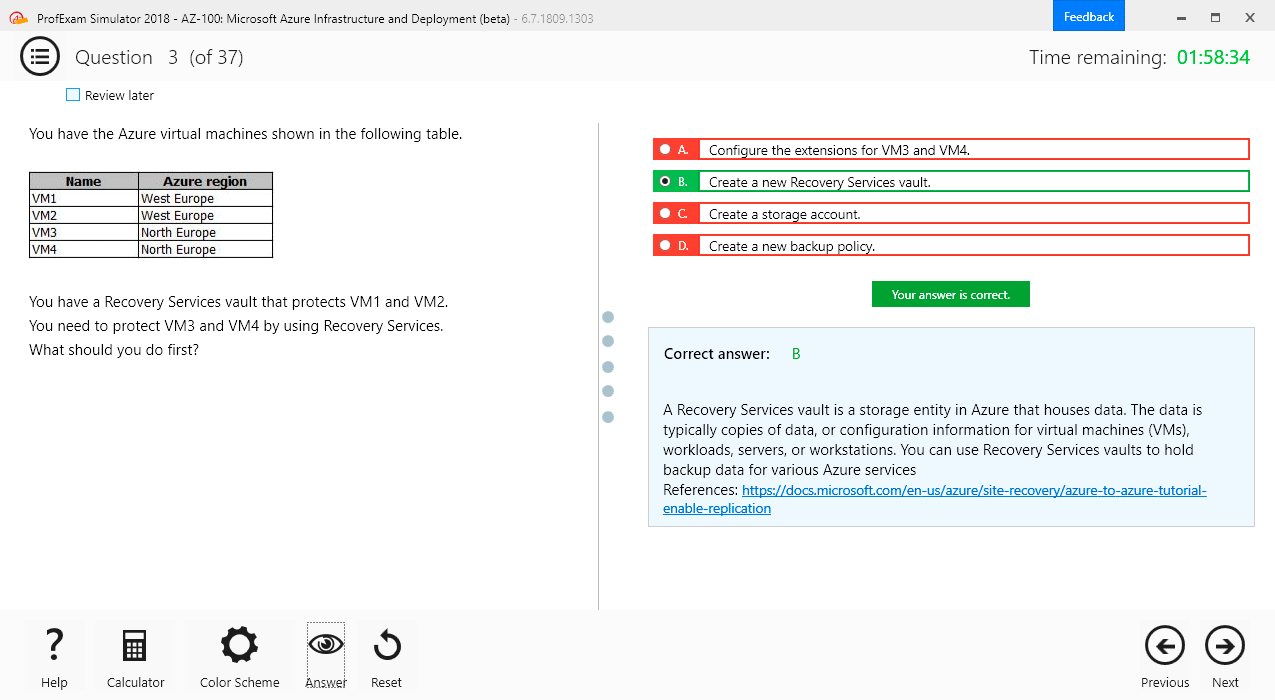
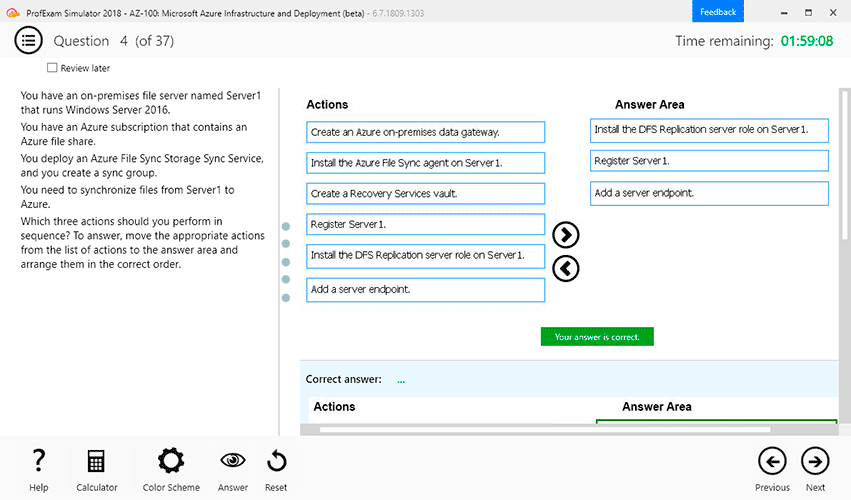
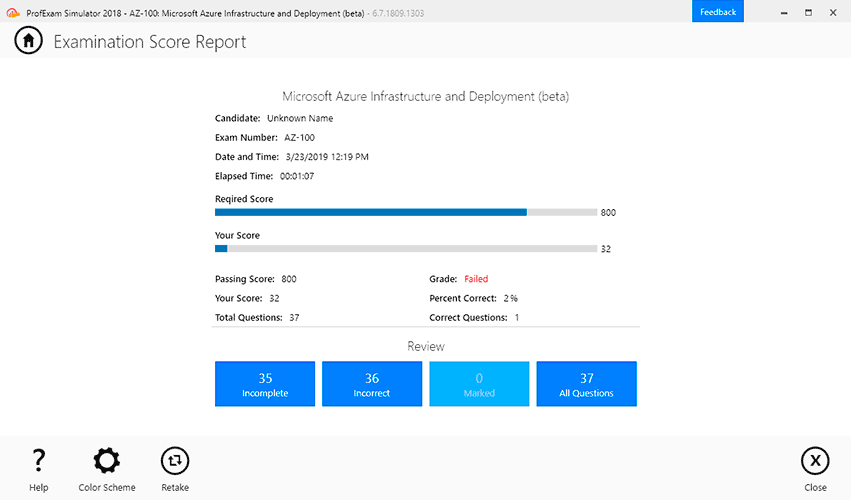
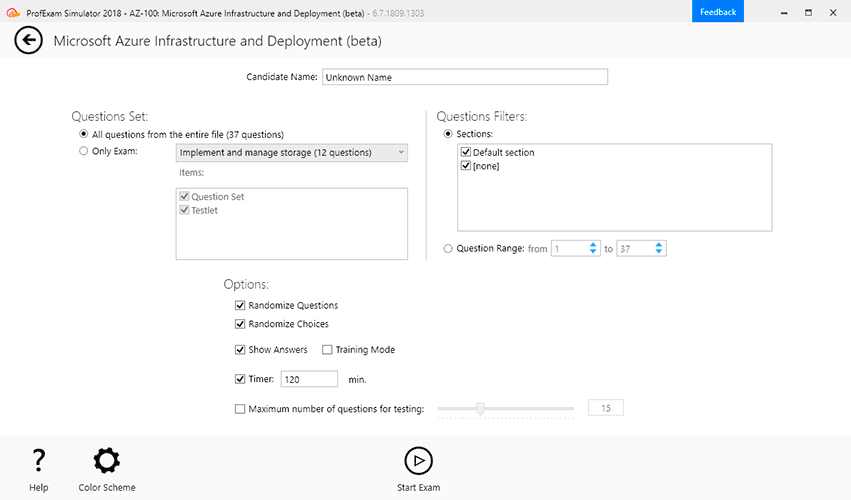

Demo Questions
Question 1
Note: This question is part of a series of questions that present the same scenario. Each question in the series contains a unique solution that might meet the stated goals. Some question sets might have more than one correct solution, while others might not have a correct solution.
After you answer a question in this section, you will NOT be able to return to it. As a result, these questions will not appear in the review screen.
Your network contains an Active Directory domain named contoso.com. The domain contains a server named Server1 that runs Windows Server 2016. The computer account for Server1 is in organizational unit (OU) named OU1.
You create a Group Policy object (GPO) named GPO1 and link GPO1 to OU1.
You need to add a domain user named User1 to the local Administrators group on Server1.
Solution: From the Computer Configuration node of GPO1, you configure the Account Policies settings.
Does this meet the goal?
- Yes
- No
Correct answer: B
Explanation:
Account Lockout Policy settings encapsulates Password Policy, Account Lockout Policy, and Kerberos Policy. It will not allow you to add a domain user to a local Administrators group. References: https://technet.microsoft.com/pt-pt/library/cc757692(v=ws.10).aspx Account Lockout Policy settings encapsulates Password Policy, Account Lockout Policy, and Kerberos Policy. It will not allow you to add a domain user to a local Administrators group.
References: https://technet.microsoft.com/pt-pt/library/cc757692(v=ws.10).aspx
Question 2
Note: This question is part of a series of questions that present the same scenario. Each question in the series contains a unique solution that might meet the stated goals. Some question sets might have more than one correct solution, while others might not have a correct solution.
After you answer a question in this section, you will NOT be able to return to it. As a result, these questions will not appear in the review screen.
Your network contains an Active Directory domain named contoso.com. The domain contains a domain controller named Server1.
You recently restored a backup of the Active Directory database from Server1 to an alternate Location. The restore operation does not interrupt the Active Directory services on Server1.
You need to make the Active Directory data in the backup accessible by using Lightweight Directory Access Protocol (LDAP).
Which tool should you use?
- Dsadd quota
- Dsmod
- Active Directory Administrative Center
- Dsacls
- Dsamain
- Active Directory Users and Computers
- Ntdsutil
- Group Policy Management Console
Correct answer: E
Explanation:
Dsamain.exe, allows an ntds.dit file to be mounted and exposed as an LDAP server, which means you can use such familiar tools as ADSIEdit, LDP.exe, and Active Directory Users and Computers to interact with a mounted database. References:http://www.itprotoday.com/windows-8/using-active-directory-snapshots-and-dsamain-tool Dsamain.exe, allows an ntds.dit file to be mounted and exposed as an LDAP server, which means you can use such familiar tools as ADSIEdit, LDP.exe, and Active Directory Users and Computers to interact with a mounted database.
References:
http://www.itprotoday.com/windows-8/using-active-directory-snapshots-and-dsamain-tool
Question 3
Note: This question is part of a series of questions that use the same or similar answer choices. An answer choice may be correct for more than one question in the series. Each question is independent of the other questions in this series. Information and details provided in a question apply only to that question.
Your network contains an Active Directory domain named contoso.com.
You need to limit the number of Active Directory Domain Services (AD DS) objects that a user can create in the domain.
Which tool should you use?
- Dsadd quota
- Dsmod
- Active Directory Administrative Center
- Dsacls
- Dsamain
- Active Directory Users and Computers
- Ntdsutil
- Group Policy Management Console
Correct answer: A
Explanation:
Dsadd quota adds a quota specification to a directory partition. A quota specification determines the maximum number of directory objects that a given security principal can own in a specified directory partition. References: http://www.gatepoint.ch/cmdreferenz/html/669c06bb-d990-4caf-a239-4bc93fb66a10.htm Dsadd quota adds a quota specification to a directory partition. A quota specification determines the maximum number of directory objects that a given security principal can own in a specified directory partition.
References: http://www.gatepoint.ch/cmdreferenz/html/669c06bb-d990-4caf-a239-4bc93fb66a10.htm
Question 4
Note: This question is part of a series of questions that use the same or similar answer choices. An answer choice may be correct for more than one question in the series. Each question is independent of the other questions in this series. Information and details provided in a question apply only to that question.
Your network contains an Active Directory forest named contoso.com. The forest functional level is Windows Server 2012 R2.
You need to ensure that a domain administrator can recover a deleted Active Directory object quickly.
Which tool should you use?
- Dsadd quota
- Dsmod
- Active Directory Administrative Center
- Dsacls
- Dsamain
- Active Directory Users and Computers
- Ntdsutil
- Group Policy Management Console
Correct answer: C
Explanation:
You can restore objects from the Active Directory Recycle Bin by using Active Directory Administrative Center. References: https://blogs.technet.microsoft.com/canitpro/2014/07/28/step-by-step-restoring-a-deleted-object-via-active-directory-recycle-bin/ You can restore objects from the Active Directory Recycle Bin by using Active Directory Administrative Center.
References: https://blogs.technet.microsoft.com/canitpro/2014/07/28/step-by-step-restoring-a-deleted-object-via-active-directory-recycle-bin/
Question 5
You have users that access web applications by using HTTPS. The web applications are located on the servers in your perimeter network. The servers use certificates obtained from an enterprise root certification authority (CA). The certificates are generated by using a custom template named WebApps. The certificate revocation list (CRL) is published to Active Directory.
When users attempt to access the web applications from the Internet, the users report that they receive a revocation warning message in their web browser. The users do not receive the message when they access the web applications from the intranet.
You need to ensure that the warning message is not generated when the users attempt to access the web applications from the Internet.
What should you do?
- Install the Certificate Enrollment Web Service role service on a server in the perimeter network.
- Modify the WebApps certificate template, and then issue the certificates used by the web application servers.
- Install the Web Application Proxy role service on a server in the perimeter network. Create a publishing point for the CA.
- Modify the CRL distribution point, and then reissue the certificates used by the web application servers.
Correct answer: D
Question 6
You network contains an Active Directory domain named contoso.com. The domain contains an enterprise certification authority (CA) named CA1.
You have a test environment that is isolated physically from the corporate network and the Internet.
You deploy a web server to the test environment. On CA1, you duplicate the Web Server template, and you name the template Web_Cert_Test.
For the web server, you need to request a certificate that does not contain the revocation information of CA1.
What should you do first?
- From the properties of CA1, allow certificates to be published to the file system.
- From the properties of CA1, select Restrict enrollment agents, and then add Web_Cert_Test to the restricted enrollment agent.
- From the properties of Web_Cert_Test, assign the Enroll permission to the guest account.
- From the properties of Web_Cert_Test, set the Compatibility setting of CA1 to Windows Server 2016.
Correct answer: D
Explanation:
The option “Do not include revocation information in issued certificates checkbox” is only available with the compatibility mode set to Windows Server 2008 R2 or later. References: http://techgenix.com/certificate-revocation-checking-test-labs/ The option “Do not include revocation information in issued certificates checkbox” is only available with the compatibility mode set to Windows Server 2008 R2 or later.
References: http://techgenix.com/certificate-revocation-checking-test-labs/
Question 7
Your network contains an Active Directory forest named contoso.com. The forest contains a single domain. The domain contains a server named Server1.
An administrator named Admin01 plans to configure Server1 as a standalone certification authority (CA).
You need to identify to which group Admin01 must be a member to configure Server1 as a standalone CA. The solution must use the principle of least privilege.
To which group should you add Admin01?
- Administrators on Server1.
- Domain Admins in contoso.com
- Cert Publishers on Server1
- Key Admins in contoso.com
Correct answer: A
Explanation:
When installing a Standalone CA, you must use an account that is a member of the local Administrators group. References: http://juventusitprofessional.blogspot.com/2015/06/active-directory-certificate-services.html When installing a Standalone CA, you must use an account that is a member of the local Administrators group.
References: http://juventusitprofessional.blogspot.com/2015/06/active-directory-certificate-services.html
Question 8
Your network contains an Active Directory forest named contoso.com. The forest contains several domains.
An administrator named Admin01 installs Windows Server 2016 on a server named Server1 and then joins Server1 to the contoso.com domain.
Admin01 plans to configure Server1 as an enterprise root certification authority (CA).
You need to ensure that Admin01 can configure Server1 as an enterprise CA. The solution must use the principle of least privilege.
To which group should you add Admin01?
- Server Operators in the contoso.com domain
- Cert Publishers on Server1
- Enterprise Key Admins in the contoso.com domain
- Enterprise Admins in the contoso.com domain.
Correct answer: D
Explanation:
To install Active Directory Certificate Services, log on as a member of both the Enterprise Admins group and the root domain's Domain Admins group. References: https://docs.microsoft.com/en-us/windows-server/networking/core-network-guide/cncg/server-certs/install-the-certification-authority To install Active Directory Certificate Services, log on as a member of both the Enterprise Admins group and the root domain's Domain Admins group.
References: https://docs.microsoft.com/en-us/windows-server/networking/core-network-guide/cncg/server-certs/install-the-certification-authority
Question 9
Your network contains an enterprise root certification authority (CA) named CA1.
Multiple computers on the network successfully enroll for certificates that will expire in one year. The certificates are based on a template named Secure_Computer. The template uses schema version 2.
You need to ensure that new certificates based on Secure_Computer are valid for three years.
What should you do?
- Modify the Validity period for the certificate template.
- Instruct users to request certificates by running the certreq.exe command.
- Instruct users to request certificates by using the Certificates console.
- Modify the Validity period for the root CA certificate.
Correct answer: A
Question 10
You deploy a new enterprise certification authority (CA) named CA1.
You plan to issue certificates based on the User certificate template.
You need to ensure that the issued certificates are valid for two years and support autoenrollment.
What should you do first?
- Run the certutil.exe command and specify the resubmit parameter.
- Duplicate the User certificate template.
- Add a new certificate template for CA1 to issue.
- Modify the Request Handling settings for the CA.
Correct answer: B
Explanation:
The built-in templates to do support allow auto-enrollment. You need to duplicate the template then modify the permissions on the new template. References: https://docs.centrify.com/en/centrify/adminref/index.html#page/cloudhelp/cloud-admin-install-create-cert-templates.html The built-in templates to do support allow auto-enrollment. You need to duplicate the template then modify the permissions on the new template.
References: https://docs.centrify.com/en/centrify/adminref/index.html#page/cloudhelp/cloud-admin-install-create-cert-templates.html

